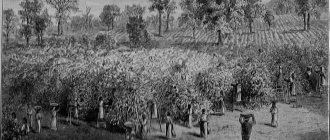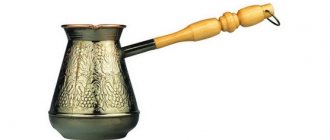And I, having slept until noon,
I smoke tobacco and drink coffee;
Transforming everyday life into a holiday,
My thoughts are spinning in chimeras...
G.R. Derzhavin, ode “Felitsa”
For the first time, our compatriots tried coffee during the reign of Alexei Mikhailovich... and were not satisfied! The drink beloved by many today was drunk reluctantly four centuries ago, like a bitter medicine. A European doctor prescribed coffee to the king “for headaches,” and the miraculous decoction apparently helped cope with severe migraines.
Goats helped us learn about coffee
Interesting facts and legends about coffee, of which there are many, indicate that this drink is very loved and consumed for a long time. It first became known in Ethiopia. The shepherd Koldi saw that the goats were eating berries, after which they became active and did not sleep even at night.
When he tried them himself, he noted that he became more alert. He shared his observation with others, and people began to eat these berries. And only after some time they began to prepare a drink from the grains. Such stories about coffee are distinguished by their originality.
Delight for noble people
Throughout the 18th century, coffee remained a drink “for the elite.” In 1791, when signing the Peace of Jassy, the Russian delegation received a diplomatic gift from the Turks: 37 pounds of coffee and jewelry. The vast majority of residents of the Russian Empire at that time did not even know about coffee. The drink did not “go beyond” the confines of noble salons and a few restaurants for a long time. Everything changed during the Napoleonic wars. When Russian troops arrived in Austria in 1805, the soldiers saw that the local population was completely drinking an unknown drink. The standard bearer of the 2nd Moscow Musketeer Regiment, Ivan Butovsky, said that the soldiers nicknamed Austrian coffee “kava” and slurped it with a spoon from large plates - just like cabbage soup.
In the Russian Empire of the 19th century, the most expensive Arabian coffee cost 30 rubles per pound, and the cheapest Brazilian coffee cost about 17 rubles. It never seriously competed with tea. At the beginning of the twentieth century, imports between these drinks varied tenfold. Coffee did not become a national drink, but it was loved by representatives of the nobility and the creative intelligentsia. Opera singer Fyodor Chaliapin recalled that he tried coffee at the age of 16, when he worked as a scribe in court: “Here I first experienced the pleasure of drinking coffee - a drink that was unknown to me until that time. They gave me coffee with cream for a nickel a glass. I received a salary of 15 rubles and, of course, could not enjoy coffee every day...”
Where do coffee beans come from?
The berries grow on trees that can reach a height of 9 meters. Trees react negatively to temperature changes. Therefore, they grow in warm climates with stable weather conditions. However, most often they are made lower to make it convenient to pick the fruits.
Large white fragrant flowers appear on the tree first, which then ripen into red berries, although these may vary slightly in color depending on the type of tree. There is grain inside. It is then processed, ground into powder and a flavored drink is prepared.
Paris Chelyabinsk and Bashkir
The Russians also liked the very sonorous word “Paris”! I liked it so much that soon after 1814, their own “Paris” appeared on the Russian map. So, in the Chebinsk region there is the village of Paris - in honor of the Nagaibak Cossacks, who formed a separate regiment in the Russian army. Interestingly, local residents are still proud of the glorious name of their village: in 2005, a cell phone tower was inaugurated in the village of Paris, designed in a form vaguely reminiscent of a small copy of the Eiffel Tower. The South Ural counterpart is six times smaller than the real one.
There is also a village in Bashkiria; the name reflects the role of local riflemen in the capture of the French capital.
Where is it produced?
There are many types of coffee trees, but most people prefer Arabica, as this type has a slightly bitter taste and a pleasant aroma. Plantations growing these fruits are located in Central and South America, Africa and Asia. The country of coffee is Brazil. It is the largest supplier of this invigorating drink. Colombia supplies 15% of the total. Moreover, Arabica beans from this country are especially valued, as they have high quality and original taste. In general, it should be noted that coffee ranks second after oil in global trade turnover. The use of this drink is widespread on all continents, so it is always in high demand. Which country consumes the most coffee? It is believed that Finland.
Science, art and coffee
In 1732, Johann Sebastian Bach wrote a coffee cantata. The musical piece ridiculed the struggle of doctors with this drink.
In 1788, the Swedish physician Gustavsson decided to test whether regular coffee consumption affected life expectancy. Criminals sentenced to life imprisonment drank three cups of coffee every day. The result of the experiment is as follows: the participants in the experiment who regularly drank coffee, despite the strict prison regulations, lived 70-80 years. However, it is important to add that Gustavsson himself lived to be 62 years old. He didn't drink coffee and lived in more comfortable conditions.
Caffeine was discovered in 1819 . The French scientist Runge was the first to isolate colorless silky crystals from coffee extract. The taste is weak, bitter. But the aqueous solution of crystals was many times superior to coffee decoction in its stimulating properties.
The discovery of caffeine became a rebirth for coffee - the plant and its fruits began to be more thoroughly studied in medicine and used as a remedy.
Data
Interesting facts about coffee have appeared over the years, so now there are a great many of them known. Let's take a look at some:
- This drink is the most popular in the world.
- In Japan, a holiday appeared in his honor. Coffee Day is celebrated on October 1st. Japan ranks third in terms of consumption of this drink.
- There is a Musanga animal that eats only coffee beans, and its excrement is then used to make a drink. By the way, it is the most expensive in the world.
- The lethal dose is 100 cups per day. If you drink such an amount, a person’s heart will not stand it.
- Coffee, if you do not add sugar, cream and milk, is an absolutely calorie-free drink.
- When this drink appeared in Russia, people did not immediately recognize it. Therefore, supporters of Peter I began to invent stories about him so that he would become popular.
- A cup of coffee won't hurt anyone. It is believed that it is safe to drink no more than 500-600 ml per day, that is, approximately 3-4 cups of 150 ml.
- Drinking the drink helps prevent Parkinson's disease, dementia, and coffee, being a strong antioxidant, prevents the formation of cancer cells.
- Coffee is used in cosmetology. In some countries they take baths with it to make the skin elastic. There are also many recipes for scrubs and masks based on ground grains.
- This drink inhibits the development of gallstone disease.
- It can also cause heartburn. The reason for this is the acid contained in it.
Look, what dwarfs!
The strangest tradition that Peter the Great observed during his travels through Western Europe was associated with... dwarfs. They first appeared on October 31, 1710 at the wedding of Peter's niece Anna Ioannovna with the Duke of Courland Friedrich Wilhelm, nephew of the King of Prussia. In the luxurious palace of Prince Menshikov, rich tables were laid, in the center of which there were huge pies. Suddenly, dwarfs and dwarfs dressed in French dresses appeared from these pies, they had fun and danced, and “the pies desecrated by their bodies were offered to the guests.” Everyone was so delighted that two weeks later, on November 14, the wedding of the jester of Peter I, the dwarf Yakim Volkov, was held in the same palace, which was attended by more than 70 “Carls” throughout Europe! After this, they began to appear at other ceremonial feasts, where entire jester tables were set up.
By the way, Anna Ioannovna’s family life with the young Duke after such a wedding lasted only... two months. In January 1711, she and her husband left for Europe, but already forty miles from St. Petersburg, the Duke died suddenly. They said that the body could not withstand the exorbitant consumption of strong drinks, which Peter persistently treated.
Wedding of the jester Yakim Volkov, 1711
Some more facts about this wonderful drink
- Instant coffee, which is now available and distributed throughout the world, was invented by George Washington back in 1910.
- In ancient times, the drink was believed to have medicinal properties. Interesting facts about coffee are known. For example, the fact that it was used as medicine to prevent diseases of the stomach and intestines, to calm the nervous system.
- There was a period when the drink was prohibited, for example, by priests. They believed that people were becoming dependent on this drink, so they were categorically against its use.
- Caffeine is on the list of prohibited substances contained in the body of athletes. Therefore, if it is detected, the competitor will not undergo doping control.
- Modern doctors deny that coffee increases blood pressure. Although this is precisely the opinion that doctors held for a long time and forbade hypertensive patients from drinking this drink.
- Since coffee has a diuretic effect, it therefore prevents fluid retention in the body. Excessive consumption can lead to dehydration.
- In one of the small towns in England, coffee is used as fuel. A power plant was built there, which requires coffee grounds to operate.
- Alcohol is prohibited for Muslims, so they replace it with coffee.
- Excessive consumption of the drink interferes with the absorption of calcium, and can also lead to insomnia and irritability.
- In Arab countries, making coffee is a man's responsibility. If he does not do this, it may lead to divorce.
- Famous people who were coffee drinkers include the great composer Beethoven and the philosopher Voltaire.
- The thicket has been used for fortune telling since ancient times and to this day.
- Drinking an invigorating drink daily helps improve memory.
- Coffee can be used for household purposes. It is suitable for cleaning pots and washing dishes. You can also renew leather clothes and make them shine by wiping them with a swab dipped in strong coffee.
Briefly about how coffee came to Europe
Coffee appeared in Europe in 1615 thanks to Venetian merchants.
The nobility became interested in the drink, which had an unusual smell and taste. However, there were also those who read a hidden threat in the uninvited guest and... recommended Pope Clement VIII to declare the favorite drink of the Ottoman Empire unclean. Pope Clementine VIII tasted the “potion”, found no danger in it for religion and the people, and blessed Christians for consuming the drink.
The first ones with the prefix “coffee”
The first coffee house in history opened in Italy in 1645. By 1763, there were more than 200 coffee shops in Venice alone.
The first coffee shop opened in London in 1652. Is it surprising that a coffee shop has appeared in the famous capital of tea lovers? The popularity of coffee among Londoners in those days is explained by the fact that the British considered coffee a good medicine. Doctors recommended a paste of ground coffee, honey and melted butter to wealthy patients. The remedy was prescribed for intestinal diseases and hysteria.
Europe's first manufactory for roasting coffee for sale opened in Antwerp, Belgium in 1863 . The production of Roode Pelikaan was launched by Joseph van Leekwijk and his sons, making high-quality coffee accessible to the common man.
Today this factory is called Pelican Rouge. To improve the quality of work, the production moved to Holland, where it produces dozens of types of coffee. Pelican Rouge is proud of centuries-old traditions and high standards in coffee production. Read more about the history of the brand here.
The fight against coffee in Europe
The first coffee house in Paris opened in 1672. Wine merchants were angry at the innovation. To maintain their position, wine traders spread the rumor that coffee was soot diluted with water. It was at the instigation of the wine elite that the Parisian clergy made coffee a public anathema.
Do you think this has stopped people from taking coffee breaks? Of course not. By the way, not only ordinary people loved coffee; for example, King Louis XV brewed coffee with his own hands.
Around this time, in 1675, the English King Charles II imposed a taboo on opening coffee shops. The monarch was wary of progressive political movements for which coffee shops would be an excellent place for discussion. But the society, which by that time had tasted the drink, was indignant. The ban was lifted after 11 days.
Another curious story of the fight against coffee happened a year earlier, also in England. In 1674, a petition was issued in London against men drinking coffee. It was signed by the women of London, who were barred from entering such public places and whose husbands disappeared in coffee shops for days on end.
Here's a quote from the petition:
“Why do our husbands waste their time, burn their insides and squander their money - all for the sake of a draft of bad, dark, thick, bitter, disgusting liquor?”
I wonder how the men reacted? They published their response to a women's petition against coffee. And, as you might have guessed, they took the side of... the black drink. The defendants claimed that coffee had a positive effect on their well-being and “gave them strength,” but their wives had bad characters and evil tongues.
The Germans and their practical approach to coffee
The Germans quickly realized that coffee could be turned into a profitable commercial project. The German coffee business developed extremely successfully and quickly.
Today German coffee brands are known all over the world: Tchibo, Jacobs, JJ Darboven.
The profitability of the coffee trade grew so quickly that the Prussian King Frederick declared a state monopoly on coffee and introduced a special position - “sniffer”.
A sniffer's job description included walking the streets of Prussian cities and sniffing out obvious coffee spirits in illegal dryers. Of course, sniffers found clandestine production and often received serious injuries from violators. There was no way to rest after work either: the sniffers were not allowed to drink beer or smoke tobacco. Nothing that could disturb the delicate sense of smell of the state “sniffer”.
How was the drink distributed in Russia?
Coffee appeared in Russia thanks to Peter I. It was he who once tried this drink abroad and decided to bring it with him. The ruler liked its taste and aroma so much that he began to gather nobles and treat them to coffee.
Then public coffee shops appeared. All other residents of the country could try the drink there. Now coffee has not lost its popularity. Thanks to its availability, everyone can afford to consume it daily.
Education of young noblewomen and noblewomen
At the same time, on the instructions of Peter I, a set of translated rules of secular etiquette was prepared for the younger generation of nobles, “The
Honest Mirror
of Youth ,” on how to behave at guests and assemblies, and it also described the rules of behavior at the table:
- When you happen to sit at the table with others, keep yourself in order. Trim your nails, wash your hands and sit decently, straight and don’t grab the first course, don’t eat like an animal, and don’t blow into your ear or soup so that it splashes everywhere, don’t sniff.
- Don’t slurp over your food like an animal, and don’t scratch your head; don’t speak without swallowing a piece.
- Be abstinent, eat as much as you need, take the last one from the dish, when they offer you something, take part of it.
- Don’t let your hands lie on the plate for a long time, don’t shake your legs. It is indecent to walk with your hands and feet on the table and wander everywhere; you must eat quietly. And do not draw, stab or knock on plates, tablecloths or dishes with forks and knives.
- When you drink, do not wipe your lips with your hand, but with a towel (or napkin), and do not drink until you have swallowed food.
- Do not lick your fingers, brush your teeth only with a toothpick, and cover your mouth with one hand when brushing your teeth.
- Don’t stain the tablecloths, and don’t make a fence of bones, bread crusts, etc. around your plate.
- When you stop eating, thank God, wash your hands and face and rinse out your mouth.
“An Honest Mirror of Youth”, 1717
Scary forecasts
Young officers were gladly accepted into the aristocratic circles of Paris. Other pastimes included visits to the fortune-telling salon of the fortune-teller known throughout Europe, Mademoiselle Lenormand. One day, eighteen-year-old Sergei Ivanovich Muravyov-Apostol, famous in battle, came to the salon with his friends. Addressing all the officers, Mademoiselle Lenormand twice ignored Muravyov-Apostol. In the end, he asked himself: “What will you tell me, madam?” Lenormand sighed: “Nothing, Monsieur...” Muravyov insisted: “At least one phrase!”
And then the fortune teller said: “Okay. I’ll say one phrase: you will be hanged!” Muravyov was taken aback, but did not believe it: “You are mistaken! I am a nobleman, and in Russia they don’t hang nobles!” - “The emperor will make an exception for you!” – Lenormand said sadly. This “adventure” was heatedly discussed among officers until Pavel Ivanovich Pestel went to see a fortune teller. When he returned, he said, laughing: “The girl has lost her mind, afraid of the Russians, who occupied her native Paris. Imagine, she predicted a rope with a crossbar for me!” But Lenormand’s fortune-telling came true in full. Both Muravyov-Apostol and Pestel did not die a natural death. Together with other Decembrists, they were hanged to the beat of a drum.
New surnames:
There is a legend: after the Patriotic War of 1812, Kalmyks, returning home, often brought their French wives to the house. At first they were popularly nicknamed “French”, then the surname French was formed.
Refinement of feelings:
Perhaps the brightest pages of those years in the history of Paris were written by the Cossacks. During their stay in the French capital, Russian cavalrymen turned the banks of the Seine into a beach area: they swam themselves and bathed their horses. “Water procedures” were taken as in our native Don - in underwear or completely naked. And this, of course, attracted considerable attention from the locals.
The popularity of the Cossacks and the great interest of Parisians in them is evidenced by the large number of novels written by French writers. Among those that have survived to this day is the novel by the famous writer Georges Sand, which is called “Cossacks in Paris.”
The Cossacks themselves were captivated by the city, although mostly by beautiful girls, gambling houses and delicious wine. The Cossacks turned out to be not very gallant gentlemen: they squeezed the hands of Parisian women like bears, ate ice cream at Tortoni's on the Boulevard of Italians and stepped on the feet of visitors to the Palais Royal and the Louvre. The Russians were seen by the French as gentle, but also not very delicate giants in their treatment. Although the brave warriors still enjoyed popularity among ladies of simple origin. So the Parisians taught them the basics of gallant treatment of girls: do not squeeze the handle too much, take it under the elbow, open the door.
Empire style in architecture:
Even before the war with Napoleon, Emperor Alexander received images of new buildings and interiors in the Empire style from the architects Fontaine and Percier. The Russian aristocracy, accustomed to imitating French fashion, quickly adopted new trends in all directions. In 1814, the Russian emperor received a French album with drawings of various projects, which played a big role in the spread of the Empire style in Russia. Alexander invited Montferrand, the future author of St. Isaac's Cathedral in St. Petersburg, but at that time an unknown architect, to his service.
Love for letters and memoirs:
Not only did Russians eat and drink in Paris, the educated part of the Russian army inspected cultural treasures with unprecedented delight. The Russian emperor himself contributed to this: he suppressed robberies and looting in the captured city, and it was especially forbidden to encroach on cultural monuments, in particular the Louvre.
France has always been famous for its literary geniuses, and almost all educated Parisians tried their hand at artistic expression. And writing letters, at the end of life, telling about your experiences in memoirs or keeping a diary was considered good manners. That is why, after the Russians visited Paris, the memoir and epistolary genres developed with particular force in Russia. Many of our officers had literary talent, and their impressions of military operations would be enough for dozens of books. Thanks to the notes, letters and diaries of participants in the military actions of 1812-1814, in the future in Russia the historical novel and fiction about that heroic time will receive special significance.
What did the Russians leave behind?
Coffee from Stalin to Brezhnev
During the Great Patriotic War, coffee was among the strategic raw materials subject to strict rationing. Natural coffee was supplied only to pilots and in minimal quantities - 30 g per month - to all wounded according to a strictly approved “hospital ration”. Other fighters were not entitled to coffee; just look at the volume of supplies to the active army. For example, on the eve of the offensive at Stalingrad, the People's Commissariat of Food supplied 688 tons of tea and only 9.3 tons of natural coffee to the front in October 1942.
During all the years of the war, coffee was not seen in the rear. Only a small number of representatives of the scientific and creative elite were supplied with it centrally - according to the order of the People's Commissariat of Trade No. 170 of June 2, 1942, academicians and corresponding members of the Academy of Sciences, all laureates of the Stalin Prize, as well as people's artists of the USSR and union republics, in addition to the goods entitled to ration cards They also received 500 g of coffee or cocoa monthly.
Who invented the Molotov cocktail? |
It is curious that such a rationed distribution and the introduction of coffee into rations for all wounded forced the Soviet Union to even increase its purchases compared to the pre-war period. In total, from June 22, 1941 to the end of 1945, the USSR imported 13,824 tons of natural coffee for an amount equivalent to 25 million pre-war rubles. Annual purchases of coffee during the war doubled compared to 1940, and before the start of massive supplies of raw materials from the United States, most of the coffee entering the USSR was purchased in Colombia.
According to the recollections of participants in the Victory Parade in June 1945, all the soldiers who were to march along Red Square were woken up that day at one in the morning and each was given a glass of coffee...
An unprecedentedly high amount of coffee for the USSR - over 9 thousand tons - was purchased in the first peaceful year of 1946, but in the next year purchases fell 15 times. And then, until Stalin’s death, purchase volumes fluctuated sharply - for example, in 1950, 1.2 thousand tons were imported (the same as in 1940), but the next year purchases increased fivefold. After the war and until the death of the leader, coffee was purchased mainly in Brazil, although diplomatic relations between these countries were severed back in 1947.
In the year after Stalin’s death, not a single kilogram of coffee was imported into the USSR; there were no purchases at all. But over the next decades, coffee imports grew continuously and rapidly. For the first time it exceeds the pre-revolutionary peak in 1959, when 13.3 thousand tons were purchased. Over the next two years, coffee imports into the USSR doubled - for the first time, the drink turned from an elite drink into one accessible to the general public.
In the first year of Brezhnev’s rule, our country imported 30.3 thousand tons of natural coffee - of this volume, 60% came from Brazil and 27% from India. In total, during the leadership of “dear Leonid Ilyich,” the consumption of natural coffee in the country increased by one and a half times. Since 1972, in the USSR, at the Dnepropetrovsk Food Concentrate Plant, its own production of instant coffee began for the first time. And although this product was traditionally considered a Soviet deficit, it was during the years of Brezhnev’s “stagnation” that a cup of coffee became a familiar companion in our lives.
What kind of person was Leonid Ilyich Brezhnev? |
Leonid Brezhnev himself had a difficult relationship with coffee. There are naive poems written in 1927 by the young Komsomol member Brezhnev, a student at the reclamation technical school, with the following lines:
“We don’t dress at all like “dandies” in simple boots, in a work blouse, they don’t drink coffee there, there’s no sherbet there, but they don’t do things in words...”
As we see, coffee was perceived by the young Brezhnev as a characteristic attribute of a completely alien existence of capitalist “dandies”. However, at the end of his life, Leonid Ilyich got used to the “bourgeois” drink and, according to the recollections of his son-in-law Yuri Churbanov, he usually started his morning with a cup of coffee with milk.
New impressions
The French, in turn, were frightened by the Asian cavalry regiments in the Russian army. For some reason they were horrified at the sight of the camels that the Kalmyks brought with them. French young ladies fainted when Tatar or Kalmyk warriors approached them in their caftans, hats, with bows over their shoulders, and with a bunch of arrows on their sides. But the Parisians really liked the Cossacks. If Russian soldiers and officers could not be distinguished from Prussians and Austrians (only by uniform). Those Cossacks were bearded, wearing trousers with stripes, exactly the same as in the pictures in French newspapers. Only real Cossacks were kind. Delighted flocks of children ran after the Russian soldiers. And Parisian men soon began to wear beards “like the Cossacks”, and knives on wide belts, like the Cossacks.
Quickly at the Bistro
The Parisians were amazed by their communication with the Russians. French newspapers wrote about them as scary “bears” from a wild country where it is always cold. And the Parisians were surprised to see tall and strong Russian soldiers, who in appearance did not differ at all from the Europeans. And the Russian officers, moreover, almost all spoke French.
There is a legend that soldiers and Cossacks entered Parisian cafes and hurried food peddlers - quickly, quickly! This is where a network of eateries in Paris called “Bistros” later appeared.
Freethinking
Paris has always been considered the center of freethinking and innovative ideas. Having visited the capital of France, the Russians, mostly peasants, saw that Europe lived differently. Peasants and soldiers expected the abolition of serfdom. The serf owners and the authorities were frightened by such sentiments of the peasants.
The government reaction intensified. It was headed by the notorious Minister of War Arakcheev. In addition, the overseas campaign gave thousands of officers the opportunity to look at Europe. Literally all the Russian officers who were then in Europe visited Paris at least once. The air of this city, where the manifesto of the Russian emperor allowed freedom of speech, press and assembly, where it was customary to address even a beggar as “Monsieur,” played a cruel joke on many. The previously abstract “freedom”, “equality” and “brotherhood” became a call to action for the Russian noble youth. The lieutenants and cornets, who were shown Europe, formed in Russia that “critical mass” that rushed to Senate Square in 1825.











